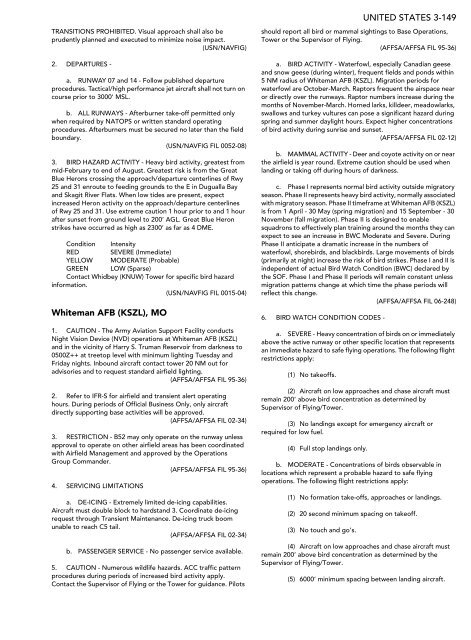NORTH AND SOUTH AMERICA - CNATRA - The US Navy
NORTH AND SOUTH AMERICA - CNATRA - The US Navy
NORTH AND SOUTH AMERICA - CNATRA - The US Navy
You also want an ePaper? Increase the reach of your titles
YUMPU automatically turns print PDFs into web optimized ePapers that Google loves.
TRANSITIONS PROHIBITED. Visual approach shall also be<br />
prudently planned and executed to minimize noise impact.<br />
(<strong>US</strong>N/NAVFIG)<br />
2. DEPARTURES -<br />
a. RUNWAY 07 and 14 - Follow published departure<br />
procedures. Tactical/high performance jet aircraft shall not turn on<br />
course prior to 3000' MSL.<br />
b. ALL RUNWAYS - Afterburner take-off permitted only<br />
when required by NATOPS or written standard operating<br />
procedures. Afterburners must be secured no later than the field<br />
boundary.<br />
(<strong>US</strong>N/NAVFIG FIL 0052-08)<br />
3. BIRD HAZARD ACTIVITY - Heavy bird activity, greatest from<br />
mid-February to end of August. Greatest risk is from the Great<br />
Blue Herons crossing the approach/departure centerlines of Rwy<br />
25 and 31 enroute to feeding grounds to the E in Dugualla Bay<br />
and Skagit River Flats. When low tides are present, expect<br />
increased Heron activity on the approach/departure centerlines<br />
of Rwy 25 and 31. Use extreme caution 1 hour prior to and 1 hour<br />
after sunset from ground level to 200’ AGL. Great Blue Heron<br />
strikes have occurred as high as 2300’ as far as 4 DME.<br />
Condition Intensity<br />
RED SEVERE (Immediate)<br />
YELLOW MODERATE (Probable)<br />
GREEN LOW (Sparse)<br />
Contact Whidbey (KNUW) Tower for specific bird hazard<br />
information.<br />
(<strong>US</strong>N/NAVFIG FIL 0015-04)<br />
Whiteman AFB (KSZL), MO<br />
1. CAUTION - <strong>The</strong> Army Aviation Support Facility conducts<br />
Night Vision Device (NVD) operations at Whiteman AFB (KSZL)<br />
and in the vicinity of Harry S. Truman Reservoir from darkness to<br />
0500Z++ at treetop level with minimum lighting Tuesday and<br />
Friday nights. Inbound aircraft contact tower 20 NM out for<br />
advisories and to request standard airfield lighting.<br />
(AFFSA/AFFSA FIL 95-36)<br />
2. Refer to IFR-S for airfield and transient alert operating<br />
hours. During periods of Official Business Only, only aircraft<br />
directly supporting base activities will be approved.<br />
(AFFSA/AFFSA FIL 02-34)<br />
3. RESTRICTION - B52 may only operate on the runway unless<br />
approval to operate on other airfield areas has been coordinated<br />
with Airfield Management and approved by the Operations<br />
Group Commander.<br />
(AFFSA/AFFSA FIL 95-36)<br />
4. SERVICING LIMITATIONS<br />
a. DE-ICING - Extremely limited de-icing capabilities.<br />
Aircraft must double block to hardstand 3. Coordinate de-icing<br />
request through Transient Maintenance. De-icing truck boom<br />
unable to reach C5 tail.<br />
(AFFSA/AFFSA FIL 02-34)<br />
b. PASSENGER SERVICE - No passenger service available.<br />
5. CAUTION - Numerous wildlife hazards. ACC traffic pattern<br />
procedures during periods of increased bird activity apply.<br />
Contact the Supervisor of Flying or the Tower for guidance. Pilots<br />
UNITED STATES 3-149<br />
should report all bird or mammal sightings to Base Operations,<br />
Tower or the Supervisor of Flying.<br />
(AFFSA/AFFSA FIL 95-36)<br />
a. BIRD ACTIVITY - Waterfowl, especially Canadian geese<br />
and snow geese (during winter), frequent fields and ponds within<br />
5 NM radius of Whiteman AFB (KSZL). Migration periods for<br />
waterfowl are October-March. Raptors frequent the airspace near<br />
or directly over the runways. Raptor numbers increase during the<br />
months of November-March. Horned larks, killdeer, meadowlarks,<br />
swallows and turkey vultures can pose a significant hazard during<br />
spring and summer daylight hours. Expect higher concentrations<br />
of bird activity during sunrise and sunset.<br />
(AFFSA/AFFSA FIL 02-12)<br />
b. MAMMAL ACTIVITY - Deer and coyote activity on or near<br />
the airfield is year round. Extreme caution should be used when<br />
landing or taking off during hours of darkness.<br />
c. Phase I represents normal bird activity outside migratory<br />
season. Phase II represents heavy bird activity, normally associated<br />
with migratory season. Phase II timeframe at Whiteman AFB (KSZL)<br />
is from 1 April - 30 May (spring migration) and 15 September - 30<br />
November (fall migration). Phase II is designed to enable<br />
squadrons to effectively plan training around the months they can<br />
expect to see an increase in BWC Moderate and Severe. During<br />
Phase II anticipate a dramatic increase in the numbers of<br />
waterfowl, shorebirds, and blackbirds. Large movements of birds<br />
(primarily at night) increase the risk of bird strikes. Phase I and II is<br />
independent of actual Bird Watch Condition (BWC) declared by<br />
the SOF. Phase I and Phase II periods will remain constant unless<br />
migration patterns change at which time the phase periods will<br />
reflect this change.<br />
(AFFSA/AFFSA FIL 06-248)<br />
6. BIRD WATCH CONDITION CODES -<br />
a. SEVERE - Heavy concentration of birds on or immediately<br />
above the active runway or other specific location that represents<br />
an immediate hazard to safe flying operations. <strong>The</strong> following flight<br />
restrictions apply:<br />
(1) No takeoffs.<br />
(2) Aircraft on low approaches and chase aircraft must<br />
remain 200’ above bird concentration as determined by<br />
Supervisor of Flying/Tower.<br />
(3) No landings except for emergency aircraft or<br />
required for low fuel.<br />
(4) Full stop landings only.<br />
b. MODERATE - Concentrations of birds observable in<br />
locations which represent a probable hazard to safe flying<br />
operations. <strong>The</strong> following flight restrictions apply:<br />
(1) No formation take-offs, approaches or landings.<br />
(2) 20 second minimum spacing on takeoff.<br />
(3) No touch and go’s.<br />
(4) Aircraft on low approaches and chase aircraft must<br />
remain 200’ above bird concentration as determined by the<br />
Supervisor of Flying/Tower.<br />
(5) 6000’ minimum spacing between landing aircraft.

















